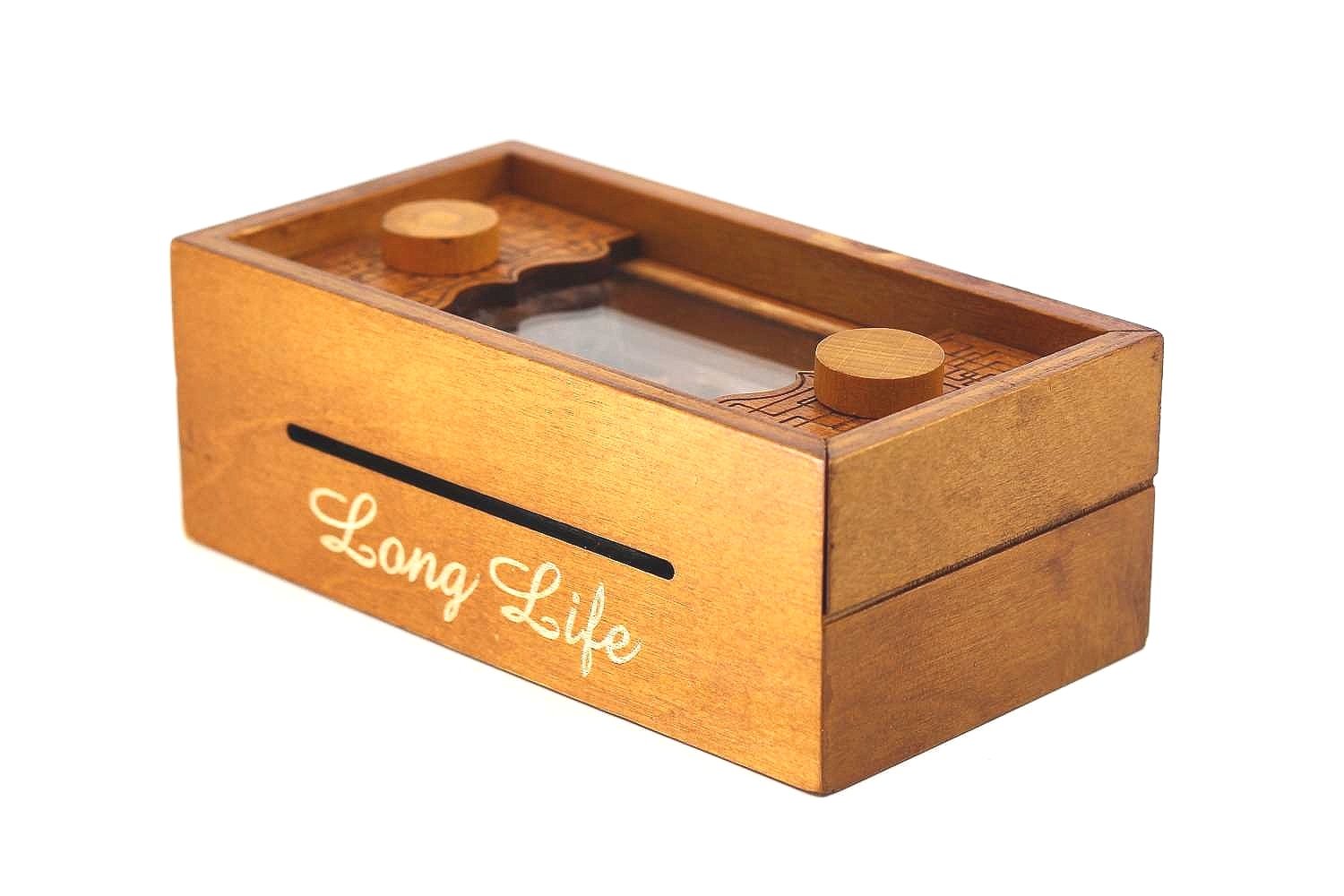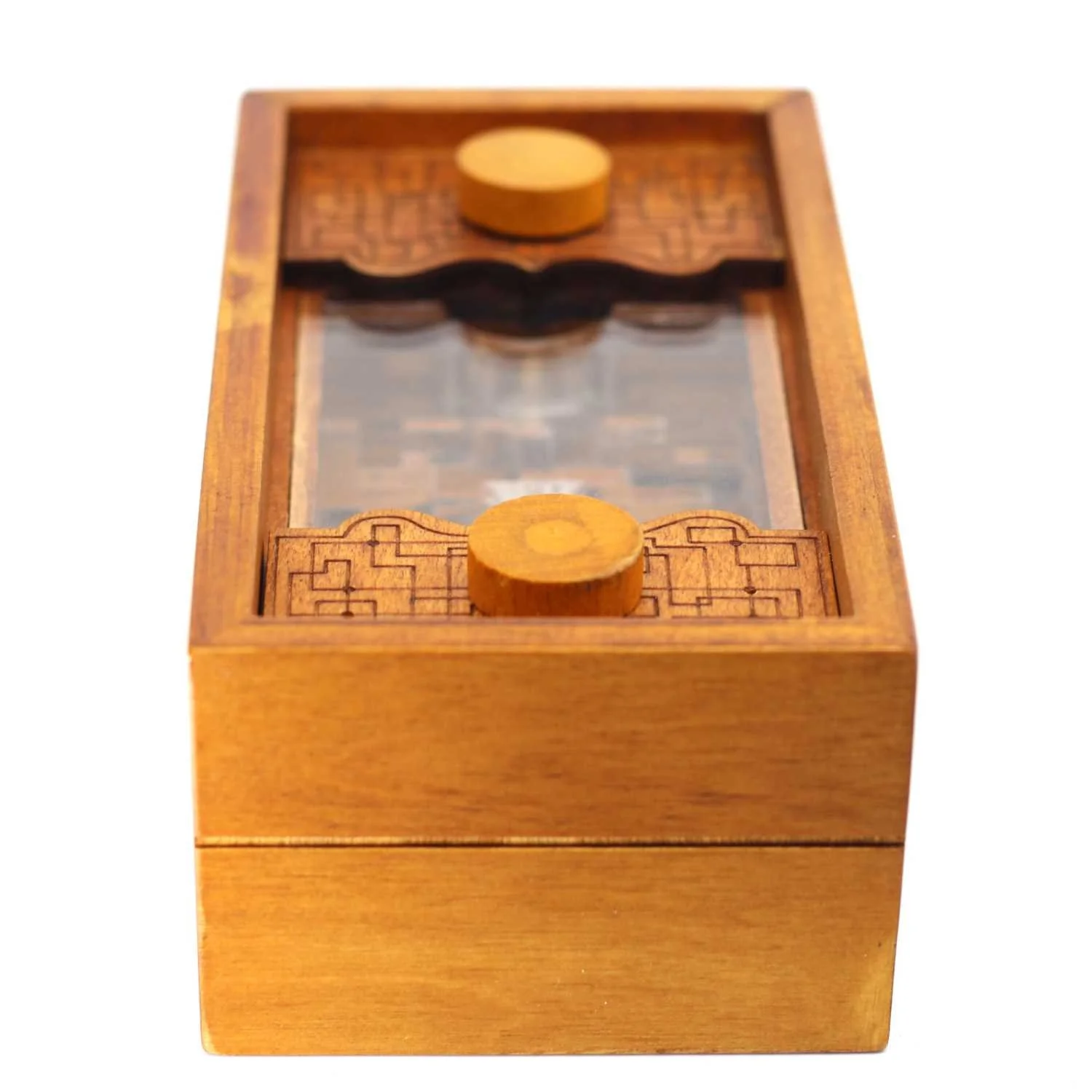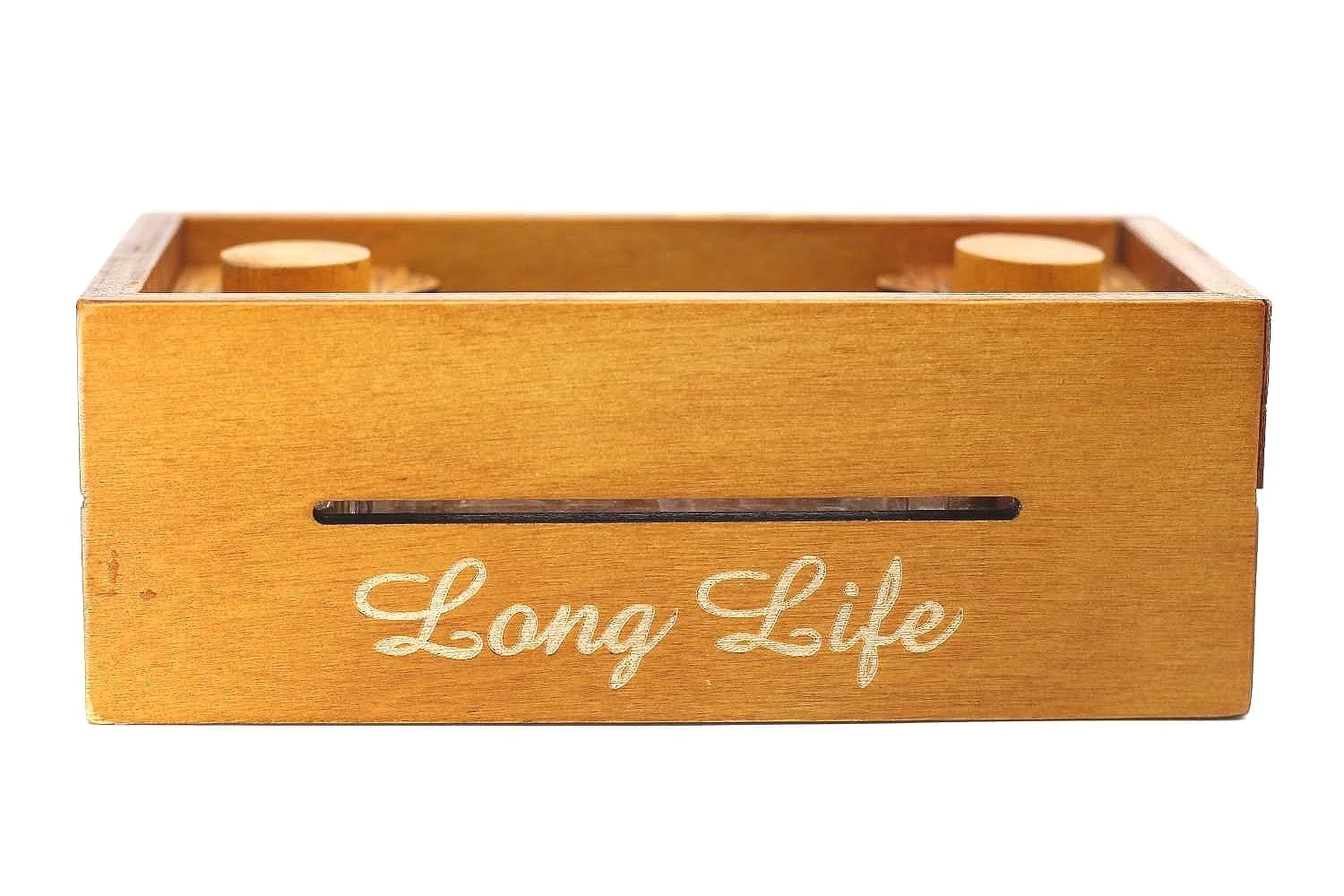Young at Heart
Houston We Had A Problem Here
Houston We Had a Problem Here by Brian Young
There’s always something abuzz at an International Puzzle Party (IPP), which often has to do with, no surprise, an interesting puzzle, perhaps spied passing hands here and there, and utterly unfamiliar. Yet in this case, (which in this case is both a grammatical phrase and a literal description), the case in question did seem familiar, and relatively unnoteworthy – so why were so many respectable people pondering over it, perplexed? Brian Young, Mr Puzzle himself, who had officially “retired”, from shop tending at any rate, if not from puzzle making entirely, thank goodness, had taken his overstock of a classic Chinese puzzle box, which is not particularly challenging by itself, and added all sorts of wonderful new conundrums inside to create something new. Brian and his wife Sue told me more about the delightful retrofit.
these boxes just aren't what they used to be ...
“We had lots of these boxes left when we closed the website. They were not a very difficult, not even particularly interesting, puzzle. We didn't like pushing them for sale on the website because they were pretty lame. (and we still do have a lot of them!)” I recall hearing Brian talk about how these boxes needed all sorts of quality control and he would have to check them and fix them before selling any. Either on these or a similar set of slightly fancier versions, he would even add a personal touch to the box, making the puzzle a bit harder in the process. So the seeds for what came next were already sown.
the big green saw in action - courtesy of Brian Young
“Brian started with an idea he had for a long time that uses a special technique to stick small magnets in the bottom of very long deep holes. He's been doing it since as far back as Katie. He thought of a new design to incorporate this but in this box it did not work. He was down the track a bit with the retrofit idea before he finally decided he could not make this work elegantly 100% of the time. He ended up going down another path and just developed the whole puzzle as he went.”
plans change ... courtesy of Brian Young
The idea to repurpose the cheaper boxes was well intentioned, clever and pragmatic, but turned out to be a lot of headache too. In the end it was probably worth it, because the puzzle turned out so well. “In hindsight it might have been cheaper and easier to throw them away. A lot of the inside of the box had to be broken out, squared up and reglued; there's nothing precise about the glue up and assembly of a cheap Chinese puzzle box :) Also when it comes to finish there are challenges. He was hoping to sand off all the original engraving but the ply is cheaply made. They use a reasonably nice veneer but very thin. And it's easy to sand through. And the filler wood inside is really crap. Not that it was even intended to be anything but an obvious retro-fit. But there was a lot of experimenting in how to finish and paint the box to make it even acceptable. He probably wasted about 30 boxes just sorting this bit out.”
will you try to ... rock it?
Each new design build reveals some new challenges in construction. In this case, the central focus point of the puzzle, the little ball bearing inside, was tricky to navigate, so to speak. “Because the ball bearing is magnetic, what Brian had not thought of when he started, is that nothing metal could be used anywhere near where the ball was running. Made it a little tricky at times to put other mechanisms/tools in the puzzle. They had to be brass or non-magnetic. Maybe he won't fall into that trap again.”
cutting down old parts … courtesy of Brian Young
Brian has been known to use a new puzzle build as an excuse to buy himself a fancy new piece of workshop equipment. But now that he is retired, he will have to work his magic with the toys … er, tools … he has thus far acquired. “I didn't have to buy any tools to make the puzzle if that's what you're asking... Sue won't let me. And the government won't let me make them tax deductible! I'm retired apparently. So I don't need anything new! As for new types of tools in the puzzle..... No real new tools but disguising them differently probably makes them a new tool. A magnet is a magnet. It's how you put them together.”
components taking shape ... courtesy of Brian Young
The finished product, “Houston We Have A Problem Here”, is a nod to the IPP in Houston where Brian debuted the puzzle and distributed the very limited number he had created. I must say it is one of the nicest gifts I received there – I’ll tell you about the other one soon, too. Brian etched a little space capsule with the Apollo 13 reference onto the top for good measure. I really enjoyed this puzzle, which has a straightforward objective, and despite its many layers is almost entirely see through, allowing you to puzzle out what must ultimately be done, and perhaps, how to get there. There are some really nice elements and mechanisms to discover on the journey. Despite being able to see everything, you will surely get stuck, and confused, before figuring things out, which feels appropriate for any budding NASA engineer. At the same time, the puzzle is extremely approachable, solvable and satisfying. “Brian always knew that this was going to be a much easier flowing puzzle than perhaps some of his other designs. He just wanted a lot of steps but not super-difficult. We have had two emails asking for some solution hint or help but in general I think most will be able to solve.”
and ... rebirth
The retrofit puzzle idea is too good to leave alone, and besides, apparently there is a lot of inventory still taking up space. We will likely see another puzzle along this theme one day. “Brian still wants to look at that original design idea that he dropped but he doesn't think it will ever work in this box. He's been thinking about it over the holiday and might be able to use it differently sometime in the future. There weren't that many [HWHAPH] made. Maybe 30+ and only hard core IPPers and friends actually got the puzzle. And there won't be any more of this exact puzzle. But he's still tinkering with the mechanism. And he'll probably produce some more for next IPP. Same box. More challenges for IPP Japan than the one in Houston. As we said the website is closed so we will only ever sell them at IPP in future.”
Elixir of Long Life by Kevin Galliano
I’m raising my glass to celebrate this fine new puzzle with a cocktail that references the original old box it is contained inside. The Elixir De Longue Vie (Elixir of Long Life) was created about ten years ago by Kevin Galliano at the Big Easy bar in London, England. I’ll spare you my Texas comments about a barbeque restaurant in Covent Garden that is named after New Orleans, ahem, but the drink is really good. It is, after all, modeled loosely on the Negroni template, or in this case the Boulevardier, which is a Negroni that replaces the gin for whiskey. You had me at Negroni.
to your good health
In this delightful retrofit, the whiskey in question is cognac, which is not actually a whiskey. Whiskey is distilled from grains, and Cognac is distilled from grape brandy. Rather than sweet vermouth, we find Pineau des Charentes, another delicious French spirit. Pineau is a sweet, most commonly white, wine which has been fortified with cognac, so naturally goes very well with more cognac. I substituted a robust, aged sweet white vermouth, having discovered that someone had pilfered the Pineau. The bitter spirit here, which is typically Campari in a Negroni, is replaced with the herbal liqueur Chartreuse, and not much of it, for that matter. So the drink profile is not nearly as bitter as a Negroni. Finally, taking the entire drink off on a tangent, we find chestnut liqueur. Again, I need to go roast some chestnuts, so in the meantime I used walnut liqueur. The drink, which promises the drinker shall be able to enjoy many more, is absolutely delicious, and I highly recommend it, to keep you Young. Cheers!
having a blast off with this pair
Elixir of Long Life by Kevin Galliano
1 1/3 oz cognac (Remy VSOP)
½ oz crème de chataigne
½ oz Pineau des Charentes blanc
1/6 oz yellow Chartreuse
2 dashes lemon bitters
Stir ingredients with ice and strain into a coupe glass. Lemon twist.
retired, or reaching new puzzling heights? - courtesy of Sue Young
explore more:














